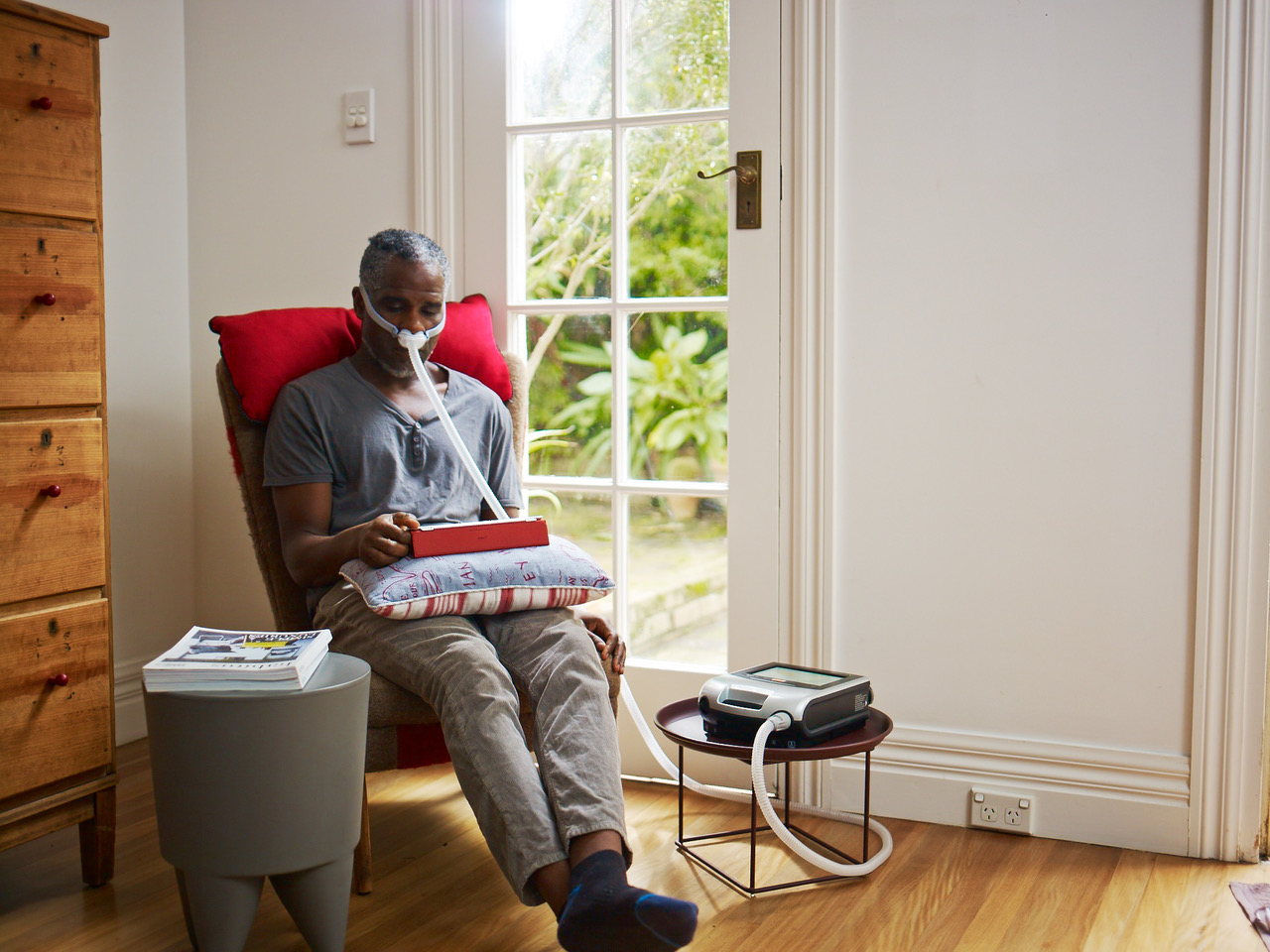What is Home Mechanical Ventilation (HMV)?
Home Mechanical Ventilation (HMV) provides a way of supporting a patient’s breathing outside of a hospital setting. The intention of the treatment is to improve quality of life and relieve symptoms.
HMV is delivered via a machine attached to a hose connected to a firm-fitting mask on the nose, mouth or via a tube in the neck (tracheostomy). Machines can deliver a steady stream of air either at a pre-decided volume, or until a set pressure is achieved, or a combination of both.
Usually, the machine provides two levels. One is a low continuous level (Expiratory Positive Airways Pressure (EPAP) which is felt as a slight resistance when breathing out to keep the lungs open for longer. The other is a higher level (Inspiratory Positive Airways Pressure (IPAP), felt when breathing in, to assist with providing a bigger breath. The machine is powered either by electricity or battery, or both.

This system can have other names depending on hospital service, country, and provider. These include Long Term Ventilation (LTV), Bi-level positive airway pressure) (Bi-Level or BIPAP) relating to the two pressures that the machine delivers and Non-Invasive Ventilation (NIV) referring to the method of delivery being via a mask and not intrusively via a tube in the mouth or neck. However, this is not a Continuous Positive Air Pressure (CPAP) machine (see final paragraph below).
Some medical conditions that relate to the lungs, nerves, and muscles can lead to a problem with moving air into and out of the lungs. Breathing feels harder work and muscles become tired. This can lead to a build-up of waste gas (carbon dioxide) and not getting enough oxygen into the blood, especially at night.
HMV may enable breathing to be more effective so muscles have time to rest. It will help to keep the oxygen and carbon dioxide levels within normal limits which will help improve sleep quality.
Therefore, using HMV may result in:
- Better energy and concentration levels during the day, to allow the completion of more daily activities.
- Reduced risk of headaches/sluggishness on waking in the morning and feeling more alert throughout the day.
- A decrease in the likelihood of being unwell and needing a hospital stay.
- Improvement in overall quality of life experienced through the improvement of symptoms and reduced periods of time with flare-ups of their condition.
Some examples of conditions that may benefit from HMV are those that obstruct the airways including:
- Chronic Obstructive Pulmonary Disease (COPD)
- Cystic Fibrosis (CF)
- Conditions that restrict the movement of air in and out of the body including Kyphoscoliosis
- Motor Neurone Disease (MND)
- Duchenne Muscular Dystrophy (DMD)
- Obesity Hypoventilation Syndrome (OHS).
Some patients experience Obstructive Sleep Apnoea (OSA) involving airway closure to the lungs and they may benefit from a continuous positive airway pressure (CPAP) to keep their airways open, particularly at night. However, some of these patients may have OSA in combination with an additional condition and if this is the case, the HMV device can be programmed to treat both conditions.
History of Home Mechanical Ventilation
HMV was first used during the Polio pandemic in the mid-20th century when patients were treated with “iron lungs’ which generated negative pressure around the patient’s chest. Since this time, it has been established as routine treatment for a range of neuromuscular diseases such as muscular dystrophy and motor neurone disease, and today, several generations of mechanical ventilators have led to an array of modes of ventilation, regulated by microprocessors and screen displays of the respiratory mechanics. They have come a long way since those early days.
Courtesy of The Newcastle upon Tyne Hospitals NHS Foundation Trust, we have included here the touching story of Maureen’s experience of early ventilation and gives fascinating insight into her recollection of contracting childhood polio and the development of non-invasive ventilation.
